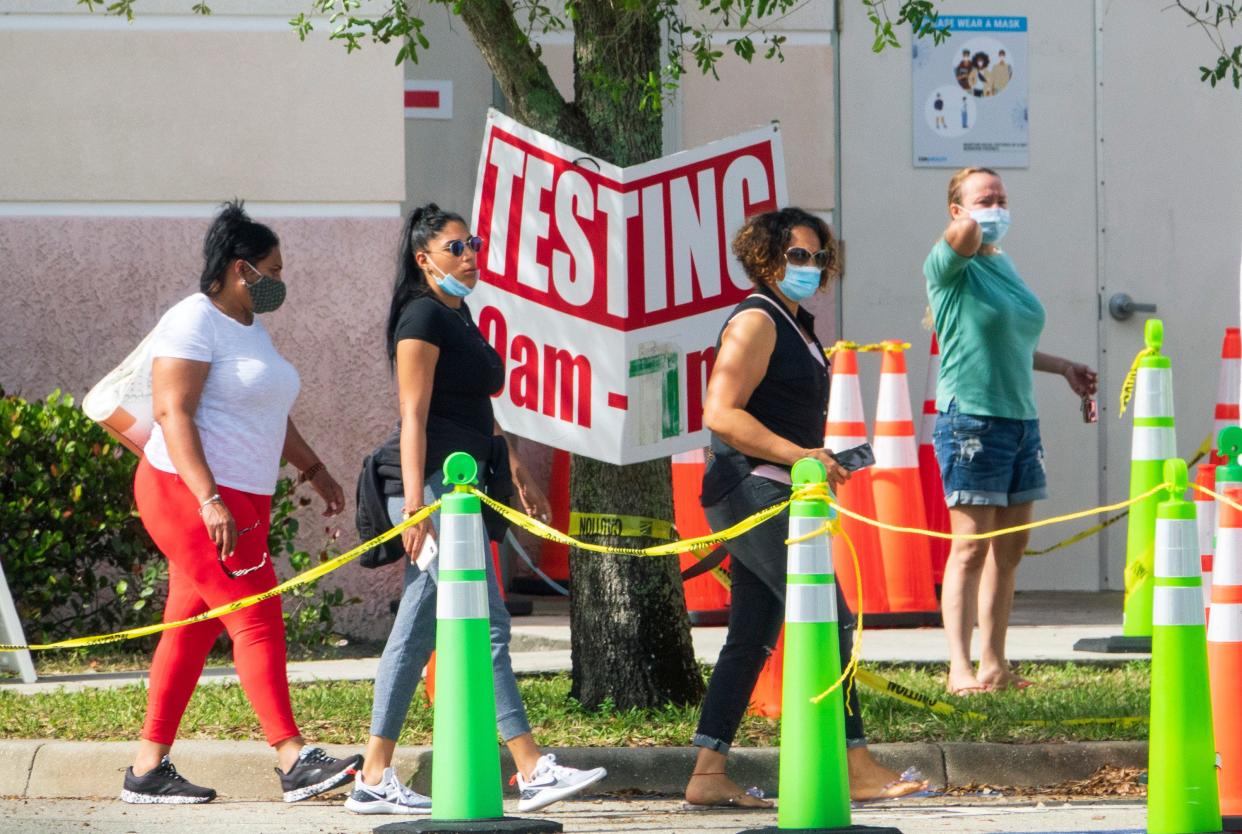COVID levels drop sharply in northern PBC, but state's cases keep rising

- Oops!Something went wrong.Please try again later.
JUPITER — The latest COVID-19 wave may be crashing, at least in northern Palm Beach County.
Viral levels in Jupiter-area sewage fell more than half between Jan. 4 and Wednesday, tests show. Other places in Florida did not report consistent declining coronavirus counts in their sewage.
Still, official statewide COVID infection numbers and hospitalizations, which trail wastewater data, continue to grow. New infections rose by some 9,000 cases over last week, to a level not seen since the beginning of September.
Scientists on Wednesday found about 966 viral fragments per milliliter of wastewater in the three Jupiter-area ZIP codes serviced by the Loxahatchee River District. That’s a 54% drop from Jan. 4. Boston-based private laboratory Biobot Analytics found more than 2,000 parts per millileter back then, the most since summer.
The district sends sewage samples several times a week to Biobot and WastewaterSCAN, a nationwide initiative that includes Stanford University. WastewaterSCAN tests have shown the virus receding in district sewage since Dec. 30. But Biobot had recorded a consistent increase between Dec. 19 and Jan. 4 before falling.
“The decline started sooner than I expected based on the predictions by many virologists of increased infections around the holidays,” district representative Bud Howard said Wednesday in an email.
Mutations of the coronavirus’ omicron variant fuel the latest COVID wave. Omicron offshoots have dominated COVID infections since last winter. “Despite these highly contagious recent variants, it is encouraging that the recent spike in virus concentrations were well below those we measured around this time last year (early 2022) in the Biobot data,” Howard wrote.
Omicron's BQ subvariants have constituted about 55% of coronavirus particles in district sewage during the past six weeks, Biobot reported Friday. The lab has yet to detect the infectious XBB-type subvariant in its Jupiter samples.
Water treatment facilities in Central Florida’s Orange and Seminole counties have yet to see a consistent slump in viral loads. WastewaterSCAN data shows increases, while Biobot shows declines since late December.
Biobot-tested sewage in Miami-Dade County, Tampa Bay’s Hillsborough and Pinellas counties, and Alachua County— home to the University of Florida — show higher viral counts than December. Biobot also found XBB subvariants in those counties, except Alachua. Biobot lacks viral variant data for that county.
Sewage testing is collected and reported in days. Cases can take at least a week before officials report it.
Florida logged almost 32,000 infections in the past week, the federal Centers for Disease Control and Prevention said Friday. It’s the most new cases since the first week of September, when infections topped 39,000. And it’s a reversal from the previous week, when a little over 23,000 new infections were reported.
But the accuracy of the official COVID case count has become unclear. Fewer people get tested at places that report to the government. The CDC collected 135,000 Floridians’ test results during the week ending Jan. 4. That’s about a third as many compared to June. The same type of decline is happening nationwide.
COVID has infected almost 7.4 million Floridians — more than one-third the population — official data says. But that misses anyone uses at-home tests or don't test at all.
COVID hospitalizations continue to rise, but there are far fewer than a year ago. Hospitals statewide tended to more than 2,900 COVID-positive patients Friday, the federal Health and Human Services Department said.
That number was more than 11,000 during this same week in January 2022. The original omicron variant engulfed the state and the nation back then.
But since then, all the major coronavirus strains have been omicron offshoots. Infection by omicron can help protect against its mutations. And federally approved booster vaccines for omicron subvariants have been available since late August.
Florida’s vaccine uptake has been sluggish. Just 10% of residents ages 5 and older have gotten the latest booster, the CDC said Friday. Nationwide, it's 16%. And 28% of Florida seniors ages 65 and older are up to date on their shots, fifth-lowest in the nation.
Florida’s COVID death toll sits above 84,000 people, the CDC reported Friday. The federal agency, which gets its numbers from the states, has the fatality count at 84,170. The Florida Department of Health reported six more than that in its latest pandemic report Jan. 6.
Chris Persaud is The Palm Beach Post's data reporter. Email him at cpersaud@pbpost.com. Click @ChrisMPersaud and follow him on Twitter.
This article originally appeared on Palm Beach Post: Jupiter area sees sharp drop in COVID viral levels as state cases rise

